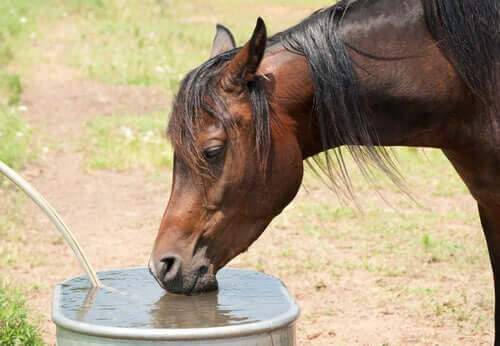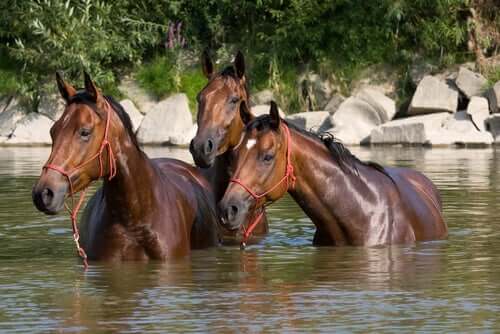How to Keep Your Horse Cool in Summer


Written and verified by the biologist Paloma de los Milagros
A horse’s body temperature increases much quicker than other animals and this makes them more sensitive to the heat. If you want to prevent your horse from getting sick, knowing how to keep your horse cool will be important.
Heat strokes in summer are a reality for all living animals. As a general rule, a horse’s body temperature should be maintained between 98 and 100 degrees Fahrenheit. If it reaches 105 or 106, it can put their health at risk and can even be fatal.
Below, we’ve listed a number of preventative measures that you can take to keep your animal from getting dehydrated.
Tips to keep your horse cool in summer
- Increase ventilation in the stable. It’s essential to have a draft so as to keep renewing the air in their stable. Opening doors and windows isn’t just important for letting in oxygen but it also lets out the fecal odor that can become quite intense at high temperatures.
- Airing the stable should be complemented with a thorough clean and the installation of mosquito nets and other measures to reduce the number of insects and pests.
- Providing them with more water is undoubtedly key to keeping your horse cool. They should always have a supply of fresh, clean water. Cleanliness is very important as many livestock diseases are brought about by inadequate disinfection.

- Encourage indirect hydration. Despite having a source of water, your horse may not drink enough. As a result, it can also be a good idea to dampen their hay or ask a vet for advice about supplements to combat a loss of salts.
- Bath them more often. Just like with humans, the best way to cool them is often with a cold shower. So that the difference in temperature isn’t too extreme, move gradually from their legs to their back, either with a hose or a damp sponge.
- Use insecticides. Apart from the mosquito nets we mentioned earlier, it’s a good idea to use insect and parasite repellents. From the start of Spring until the end of Summer, any increase in numbers can cause health problems for your horse. The most common problem is ‘summer seasonal recurrent dermatitis’.
Plan their outings and check their hydration
- Plan their outings. Walks through the fields or exercise should be saved for the cooler parts of the day. It’s also a good idea to have some trees or areas where your horse can find shade. If possible, there should be an extra source of water too.

- Check that your horse isn’t dehydrated. One symptom of dehydration is the elasticity of your horse’s skin. You can check this by gently pinching a section on the neck or back and seeing if it recovers its original shape when you release it. It’s also a good idea to check the condition of their mucosa (it should be pink) and check for clear urine.
- Check their recovery capacity by observing their vital signs. After exercise or a shower, make sure that their heartbeat and breathing maintain an appropriate rhythm.
Horses are some of the most cared-for animals on a farm. But during the summer they’re particularly sensitive and making sure that they’re well-hydrated, external and internally, is vital.
All cited sources were thoroughly reviewed by our team to ensure their quality, reliability, currency, and validity. The bibliography of this article was considered reliable and of academic or scientific accuracy.
- Fullcover. ¿Cómo cuidar a nuestros caballos durante esta ola de calor? (s.f). Recuperado de https://www.fullcover.eu/es/blog/como-cuidar-a-nuestros-caballos-durante-esta-ola-de-calor
- Ventura, L. (2018). Equisens. La sensibilidad del caballo al calor. Recuperado de https://www.equisens.es/biologia/la-sensibilidad-del-caballo-al-calor/
- Zotal laboratorios. Cuidados de los caballos durante los meses de calor. (s.f) Recuperado de http://www.zotal.com/cuidado-caballos-meses-calor/
This text is provided for informational purposes only and does not replace consultation with a professional. If in doubt, consult your specialist.